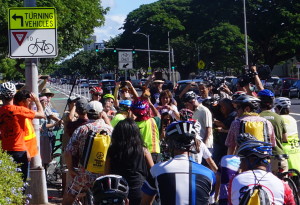It’s been over a year since the City and County of Honolulu installed Hawaii’s first protected bike lane. After riding it several times a week since it was added, I’ve noticed a few things. First, after a somewhat frustrating break-in period, bicyclists and drivers have gotten better at anticipating each others actions, and both types of traffic seem to move more smoothly. However, there are still situations that require extra caution, and they are different depending on which direction you travel in the two-way bike lane.
When riding ewa-bound I worry about cars pulling out of driveways onto King, and when riding Koko Head-bound I worry about cars turning left off of King. It’s hard to mitigate the threat when travelling ewa-bound, since you’re going against traffic. Whether the bike lane is on the left side or the right side, cars turning out will instinctively look towards the vehicle traffic and not necessarily consider bicycles traveling from the other direction. (There are signs at each driveway reminding drivers to look both ways, but it’s still not something that they do instinctively yet.)
When riding Koko Head-bound with traffic, there is a new type of car/bicycle conflict related to cars turning left across the bike lane, since drivers are not use to looking out for bikes on the left side of the road. Hawaii law (§291C-145) has conditioned drivers to expect bicycles on the right side of the road. While it allows them to take the full lane when required for safety, it requires bicyclists to otherwise ride on the ride side of the traffic lane. There is an exception for riding on the left side of a one-way road, but most cyclists I’ve seen (myself included) tend to stick to the right side even on one-way streets. The main reason I do this is because it’s what car drivers expect and, oddly enough, it gives a better chance to be seen by turning vehicles.
At first it seemed odd that I felt safer riding on the right side of the road than on the left, since it puts me farther away from the driver of a car. However, drivers seem to have a harder time seeing me when turning left across my path than when turning right. It turns out that most drivers have a better field of view to spot cyclists when turning right. (Large trucks are a notable exception.) In order to check a blind spot before turning, a driver’s head doesn’t have to swivel as far to look behind to the right as it does to look behind to the left. I’ve noticed that the conscientious drivers who make sure it’s clear before turning left off King Street practically have to turn around in their seats to check for cyclists; they might know that they passed one but don’t know how far back the bike is and whether it’s safe to turn.
The main reason the protected bike lane was added on the left side of King Street was to avoid interference with TheBus. There is already a degree of conflict between bikes and buses in a standard bike lane, since buses need to stop across the lane in order to reach the curb to pick up and drop off passengers. However, a protected bike lane prevents the bus from reaching the curb, meaning that additional mitigation efforts are needed. Many cities use floating bus stops where the protected bike lane passes behind the bus stop, and riders are picked up from a separate island. (The progression would be: sidewalk, bike lane, waiting area for bus stop, and then traffic lane.) However, features such as this require more space and also much more time and money to construct. Moving the protected lane to the left side of the road was by far the cheapest and easiest way to address this conflict, which is why it was the course chosen for King Street.

Mayor Caldwell talking to the press after installing the first bicycle-specific stop light on King Street. Image copyright KHON2 (via YouTube).
During a press conference about the King Street Protected Bike Lane being expanded for use in both directions, Mayor Caldwell mentioned that residents were initially in an uproar when King Street was changed from two-way to one-way street. With time it was accepted, and now most people can’t imagine going back. (I never even knew that was the case before the Mayor referenced it.) From what I’ve seen, drivers have started to accept and adapt to the new protected bike lane on King Street. The next step will be to create additional bike routes that feed into a minimum grid network, since a fancy bike lane is no good if it doesn’t go anywhere.


